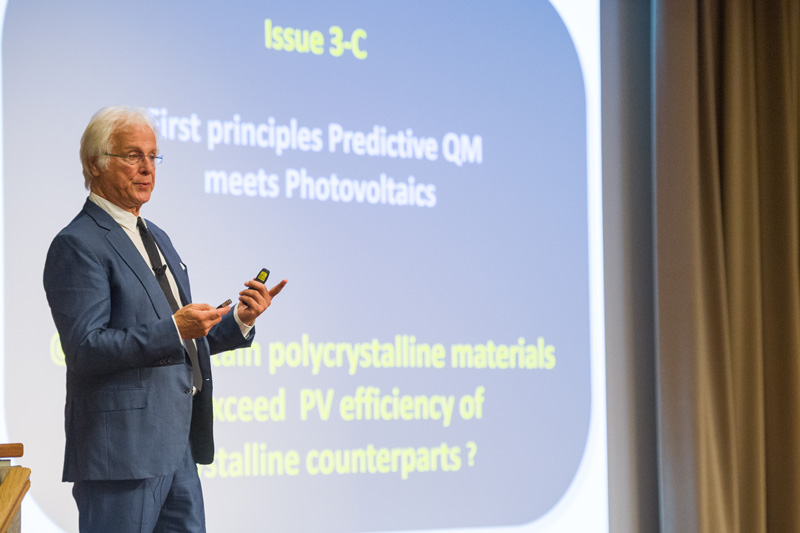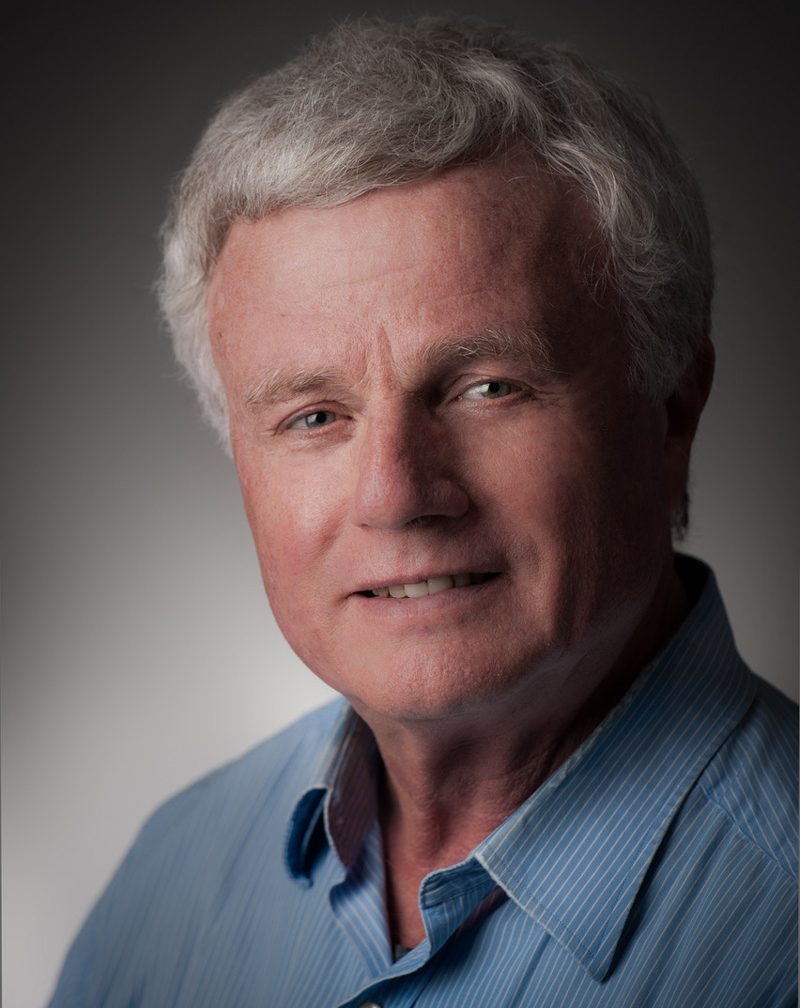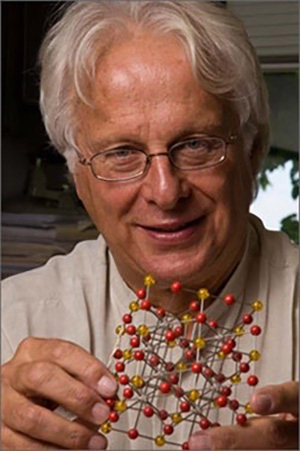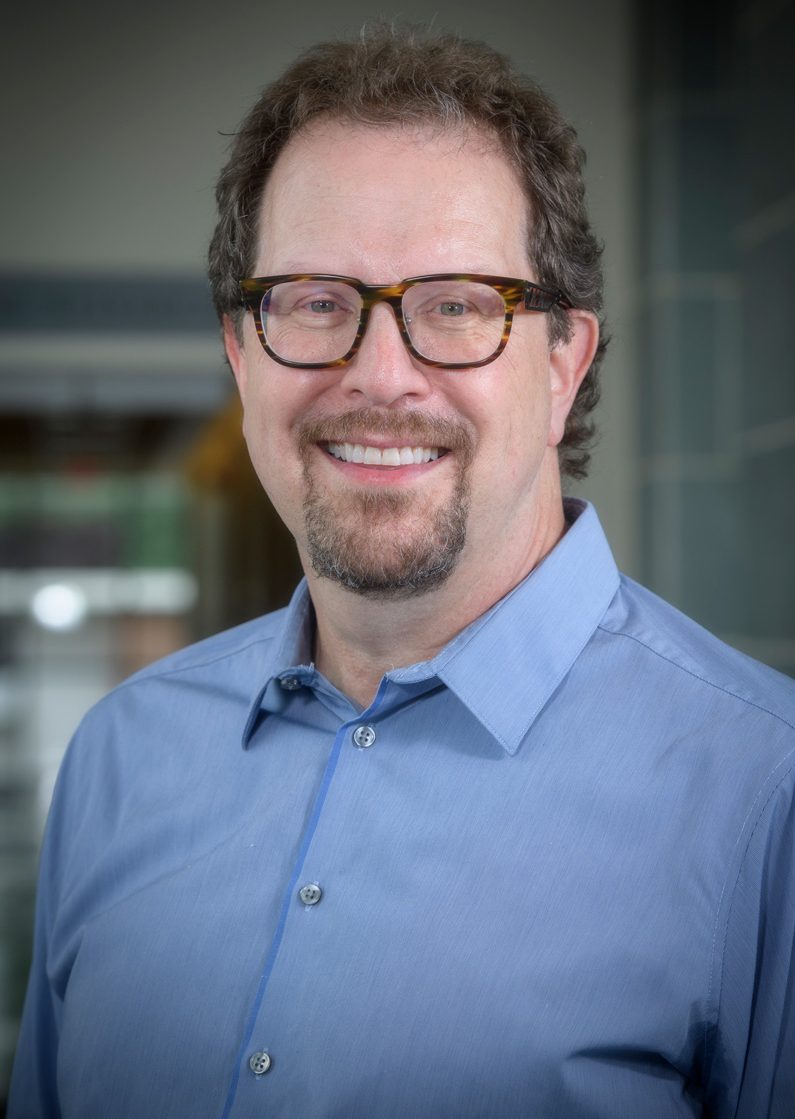


Let the light shine
Photo by Kathy F. Atkinson October 12, 2018
Luminaries predict future of solar energy as 14th Böer Medal of Merit awarded
The word “luminary” traces its roots to the Latin word lumen — for light. In English, illuminate means to light up, while luminous means to emit light.
Merriam-Webster defines luminary as “a person of prominence or brilliant achievement.”
It is a fitting description for Alex Zunger, a solar scientist who has pioneered new theories to improve the performance of solar devices and used unconventional approaches to find new materials to power solar technology, now and in the future.
Zunger, a professor at the University of Colorado, Boulder, was awarded the 2018 Karl Böer Solar Energy Medal of Merit during a ceremony held at University of Delaware’s John M. Clayton Hall on Friday, Oct. 12.
“Over the past 25 years, the Böer Medal has recognized those who’ve made significant pioneering or enduring contributions in solar, wind or other forms of renewable energy. Today we add Dr. Zunger’s name to these prestigious ranks,” UD President Dennis Assanis said at the ceremony.
A memorial service for the medal’s namesake, Karl W. Böer, who passed away earlier this year at the age of 92, was held earlier in the day. Böer was a renowned scholar, physicist and inventor who championed the development of solar energy technology worldwide.
Under Böer’s leadership, projects like Solar One, the first experimental house to convert sunlight into both heat and electricity using thin-film solar cells, demonstrated solar energy’s potential and practical use to the average person. The house was erected by UD’s Institute of Energy Conversion and completed in 1973, and still sits off South Chapel Street in Newark, Delaware.
So, how has the solar energy industry grown in the 45 years since researchers involved with Solar One flipped that first solar switch, and where is the industry headed? Four solar luminaries weigh in on our solar energy future.
UDaily: What will the solar energy world look like by 2050?

Charlie Gay, director of the U.S. Department of Energy, Solar Energy Technologies Office:
Karl Böer paved the road I’ve been traveling for the past 44 years. The first oil embargo started in October 1973 at the same time I was finalizing my grad school work. Karl created the Solar One house, also in 1973. Inspired in part by his pioneering vision, I changed my career trajectory to follow the sun. The speed of progress has been exponential.
Today, solar provides two percent of America’s electricity needs and is one of the fastest growing industries in the U.S. Over the past eight years alone, the cost of solar has fallen more than 80 percent. The U.S. Department of Energy has set a target of further reducing today’s cost by 50 percent, as soon as 2030. This would result in solar being one of the least expensive options for new power generation. At that price — $0.03 per kilowatt hour — solar could reasonably compete for nearly 30 percent of our electricity needs by mid-century.
If energy storage costs also decline at an exponential rate, solar could be in the running to supply nearly half of our electricity needs by 2050.

David Renné, president, International Solar Energy Society:
By 2050, global installed solar capacity will exceed nine terawatts (nine times 2022 levels) and will represent about 25 percent of the world’s electricity supply. Many cities, island nations and regions around the world will have achieved 100 percent renewable energy, the majority of which will be supplied through solar electricity, primarily by distributed and central station solar technologies plus low-cost utility-scale battery systems.
Building-integrated photovoltaic applications will also make a sizeable contribution to the electricity sector, especially on newer buildings throughout the world’s mega-cities. The near-complete electrification of personal and mass transit, as well as growing electrification of the heating and cooling sector, will mean that over 40 percent of our end use energy consumption will come from electricity (compared to 20 percent today). The mix of solar technologies will be different from today, too, with innovations in areas such as nanotechnology and organic solar cells replacing or improving upon conventional polycrystalline and even monocrystalline systems in many cases.
Finally, much of today’s off-grid electricity market will be supplied by smart micropower systems, with solar and battery storage providing the bulk of the energy supply, especially on islands and in those areas where grid extension will never occur or does not provide adequate service. In this case, the United Nations’ Sustainable Development Goal #7 — to ensure access to affordable, reliable, sustainable and modern energy for all — will have been achieved in the sense that virtually every person on the planet will have access to reliable electricity services.

Alex Zunger, professor at the University of Colorado, Boulder, and 2018 Böer medal recipient:
The materials used today for solar energy conversion — silicon (Si), cadmium telluride (CdTe) and copper indium di selenide (CuInSe2) — were developed over approximately 40 years by slow incremental improvements based largely on Edisonian trial and error, reaching about 20+ percent efficiency.
The scientific community must have felt that tweaking the materials that were discovered long ago was the way to go, as almost no other material options were examined. In my view, it is unlikely that these core materials will be used in 2050 simply because they do not represent the result of a science-based search of other options.
New, currently undiscovered materials will leapfrog the old ones by reaching high efficiency much faster while being at the same time stable and cheap. For example, halide perovskites are novel materials that have reached recently 23 percent efficiency in just five years of research, casting serious question on the methodology used previously to discover photovoltaic materials.

William Shafarman, director of UD’s Institute for Energy Conversion:
In 2050 we will see solar energy seemingly everywhere, often combined with battery storage. Solar will be our biggest source of electricity generation.
As prices for both solar and storage continue to drop, we will power all kinds of things with clean electricity that we don't think of now, including cars and other transportation, home heating and factories. This will require a wide variety of solar energy technology for uses in large utility-scale electricity, direct integration into homes and many buildings, as well as flexible and other solar cells fully integrated into most electronic devices.
About the Böer Medal
Given biennially, the Karl W. Böer Solar Energy Medal of Merit was established at the University of Delaware in 1983 in honor of visionary solar scientist Karl Wolfgang Böer, founder of the University’s Institute of Energy Conversion.
The award recognizes an individual who has made significant and lasting contributions to the field of renewable energy. It includes a $60,000 prize.
To date, 14 esteemed visionaries have received this prestigious honor, which includes world leaders, Nobel laureates, Einstein Award winners and directors of research institutes in the U.S. and abroad. U.S. President Jimmy Carter was the first awardee in 1983.
To learn more about Karl Böer’s career, visit the Karl W. Böer, Solar Luminary: In Memoriam case exhibit on the second floor of UD’s Morris Library. The exhibit will be on view throughout October.
Contact Us
Have a UDaily story idea?
Contact us at ocm@udel.edu
Members of the press
Contact us at 302-831-NEWS or visit the Media Relations website

